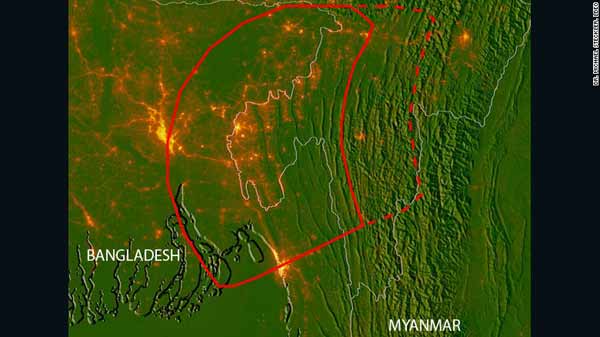
Dhaka, Bangladesh (BBN) - The Ganges and Brahmaputra rivers are critically important, life-giving rivers for hundreds of millions of people living in India and Bangladesh.
But the millions of tons of sediment that pile up in the delta region of these rivers, a large portion of Bangladesh, could be hiding the biggest natural disaster the region has ever seen, reports CNN.
According to recently released research from a team of scientists led by Dr Michael Steckler from Columbia University, buried under miles of sediment lies a locked and loaded megathrust fault that could unleash an earthquake up to 9.0 magnitude in one of the most densely populated regions of the world.
MEGATHRUST FAULTS PRODUCE BIGGEST QUAKES
Megathrust faults occur at subduction zones, where Earth's tectonic plates are colliding with each other and one plate is moving (or "subducting") under another.
These faults produce the largest earthquakes, reaching and even exceeding 9.0 magnitude, with recent examples being the 2011 Japan earthquake and tsunami, as well as the 2004 Banda Aceh earthquake and resulting Indian Ocean tsunami.
A vast majority of these megathrust faults and their resulting earthquakes occur under the ocean, which is why they can unleash tsunamis.
It is rare to find these types of faults under land, and even more rare -- and potentially catastrophic -- to have one directly underneath such a major population center.
The study indicates that more than 140 million people live within 100 kilometers (60 miles) of this fault in Bangladesh, India and Myanmar.
While the fault lines in this region have been known about for some time, most believed the subduction, and thus the major earthquake threat, had long since ended.
Studying the motion of the plates and looking for evidence of seismic movements in Bangladesh is extremely difficult.
Steckler, the lead author of the study, described the subduction zone as being "filled with sediments from the Ganges-Brahmaputra Delta," causing the fault to be "blind, totally covered by sediments, so in places we only infer its existence."
This study utilized more than 10 years' worth of data from highly precise GPS receivers placed around northeast India, Bangladesh and Myanmar.
The results allowed the researchers to "see the motion of the plates and the deformation around the fault due to the two sides being locked together," according to Steckler.
The motion builds up tension along the plate boundary and that strain will eventually be released in an earthquake somewhere along that fault.
The researchers estimate the earthquake would have a magnitude in the range of 8.2 to 9.0, which would have devastating consequences for the tens of millions of people unfortunate enough to live near the epicenter.
CRITICALLY VULNERABLE TO EARTHQUAKES
Bangladesh is consistently ranked one of the most vulnerable countries to natural disasters, but this is primarily because of the frequent occurrence of tropical cyclones, floods, heat waves and other weather-related disasters, combined with the massive population living in vulnerable conditions.
The same structures that are vulnerable to weather disasters are equally vulnerable to earthquake shaking, and the enormous population in and around Dhaka make that risk even greater.
The massive amounts of sand and sediment in the soil of the delta region that makes up much of Bangladesh presents another danger, in addition to hiding the potentially devastating megathrust fault.
In an earthquake, the shaking will cause the sandy ground to behave like a liquid in a process known as liquefaction.
This makes the shaking even more devastating to buildings built on this sandy ground.
We saw firsthand how devastating this can be during an earthquake on a coastal city in 2010, when a 7.0 magnitude quake struck Port-au-Prince, Haiti, killing more than 200,000 people.
MUCH WORSE THAN HAITI
The potential destruction from the earthquake warned about in this study would be much worse than in Haiti.
An 8.0 magnitude earthquake (which is slightly lower than the potential 8.2-9.0 max that this fault could trigger) is 32 times stronger than a 7.0 earthquake.
If that quake was to strike under Dhaka, which has a population of around 7 million, compared to Port-au-Prince, which has a population of about 1 million, the resulting death toll could be staggering.
Steckler said, "The strain is building up and will sometime be released by an earthquake," but the timing, of course, is unknown.
It could happen tomorrow or it could happen in 500 years, but hopefully with increased knowledge of the risk, Steckler said he hopes the governments of India and Bangladesh "can focus efforts on building more earthquake resistant structures," as well as "improve planning to cope with relief and supplies for the people after an earthquake."
BBN/MS/ANS